A fabulous cup of coffee depends on several key factors: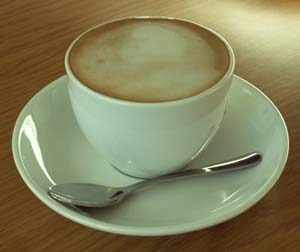
- The quality of the beans
- Where and how the coffee is grown
- The roasting process
- The brewing method
Buy the freshest coffee possible, and store the beans in an airtight container in a cool, dry place. Whole beans stay fresh longer than ground. If the coffee has been ground, consume it right away. Ground coffee begins losing its aroma within 15 minutes and can go stale within hours if exposed to air. Coffee’s three primary foes are light, air and moisture.
Grinding
Grind coffee just before brewing using the correct grind for your brewing method. Faster cycles require finer grounds for proper extraction. Use a coarse grind for a slower brewing process.
Grind according to the type of coffee maker that will be used. Grind the coffee as fine as you can make it without losing any through the holes in the filter of the coffee maker. Never grind coffee to a powder. The finer the grind, the more contact there will be between coffee and hot water, and the faster and more thoroughly the essential oils will be released, without activating harsher, less-soluble chemicals.
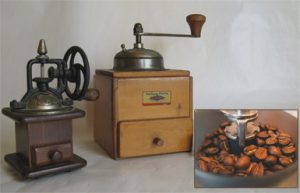
There are 4 ways to grind coffee, the oldest being the mortar and pestal. The next oldest is the millstone, updated to steel burrs or corrugated plates. The next is the roller mill, which is used only in giant commercial grinders. The most recent is the electric blade grinder, which works on the same principle as an electric blender. Grinding with a good quality burr grinder is preferable. Though utilizing a burr grinder is optimal, buying whole bean coffee and grinding with an inexpensive blade grinder is still better than purchasing already ground coffee.
Proportions
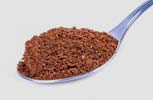 The recommended proportion of coffee to water is two level tablespoons (one standard coffee measure) per 6 ounces of water for regular strength coffee. Don’t skimp. Using too few grounds may make the coffee taste bitter from over-extraction. Experiment to determine the strength you prefer.
The recommended proportion of coffee to water is two level tablespoons (one standard coffee measure) per 6 ounces of water for regular strength coffee. Don’t skimp. Using too few grounds may make the coffee taste bitter from over-extraction. Experiment to determine the strength you prefer.
Water and Brewing Temperature
Coffee is almost 99% water. so the better the water, the better the coffee taste. Do not use softened water, as it inhibits proper extraction. Use fresh water, as free of impurities and alkalines as possible. If the water is not pleasant to drink, do not make coffee with it. Use bottled water or a filter system. Hard, or alkaline, water does not directly harm flavor and aroma but does mute some of the natural acids in coffee and produces a blander cup with less dry brightness. Water that has been treated with softeners makes even worse coffee, however, so if you do live in an area with hard water, you might compensate by buying more acidy coffees (African, Arabian, Central America).
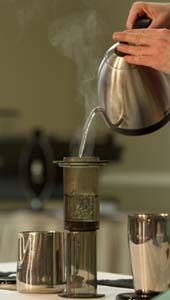 Brew with hot water, as opposed to lukewarm or boiling water (Middle Eastern and cold-water coffees are exceptions). A temperature of 200°F is ideal, which means bringing the water to a boil and then waiting a second or two before brewing. Boiling damages coffee flavor because it vaporizes much of the coffee essence while it continues to extract other bitter-tasting chemicals. The French began steeping, as opposed to boiling, coffee in the early eighteenth century, but this innovation did not penetrate the coffee-drinking mainstream until the nineteenth century and had to wait until the 20th century to triumph. Today, all American and European methods favor hot water (around 200°F), as opposed to boiling.
Brew with hot water, as opposed to lukewarm or boiling water (Middle Eastern and cold-water coffees are exceptions). A temperature of 200°F is ideal, which means bringing the water to a boil and then waiting a second or two before brewing. Boiling damages coffee flavor because it vaporizes much of the coffee essence while it continues to extract other bitter-tasting chemicals. The French began steeping, as opposed to boiling, coffee in the early eighteenth century, but this innovation did not penetrate the coffee-drinking mainstream until the nineteenth century and had to wait until the 20th century to triumph. Today, all American and European methods favor hot water (around 200°F), as opposed to boiling.
Steep coffee in cold water and get substantially the same results as with hot water. The only differences are that the process takes longer (several hours longer) and makes an extremely mild brew. Cold-water coffee is made concentrated and, like instant, is mixed with hot water.
Don’t percolate or reheat coffee; it has the same effect as boiling, only less so. Don’t hold coffee on heat for more than a few minutes for the same reason as above. Coffee left on a heated burner may taste bitter. Remove to a thermal carafe.
Storing Coffee
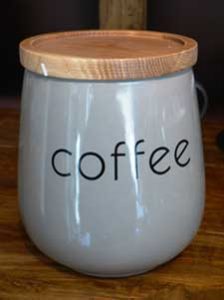 To help prolong the life of your coffee, store it in an airtight container in a dark, dry place. Buy your coffee no more than one week before using it and grind your beans just before brewing. Never store in your freezer or refrigerator!!! If you must store your beans in the freezer, defrost only the amount you will need one half hour before grinding and brewing. Ground coffee is only good for no more than 2 hours (no matter how you store it) so don’t grind more than you need. Whole beans maintain most the flavor up to 21 days if stored properly.
To help prolong the life of your coffee, store it in an airtight container in a dark, dry place. Buy your coffee no more than one week before using it and grind your beans just before brewing. Never store in your freezer or refrigerator!!! If you must store your beans in the freezer, defrost only the amount you will need one half hour before grinding and brewing. Ground coffee is only good for no more than 2 hours (no matter how you store it) so don’t grind more than you need. Whole beans maintain most the flavor up to 21 days if stored properly.
Storing coffee properly will keep it fresh and help it retain its flavor for as long as possible. Keep in mind that the main objective is to keep your coffee away from air and moisture, which deplete the flavorful oils.
To Freeze or Not
For every article you seeing declaring the evils of freezing, you can find one strongly advocating it as the best storage technique. Some roasters freeze as soon after roasting as possible. Others shutter at the mere suggestion. Technically, freezing can alter the coffee and, therefore, theoretically, could affect the taste.
After you open your coffee package, transfer the contents to an airtight container. It is suggested NOT to store coffee in the freezer. 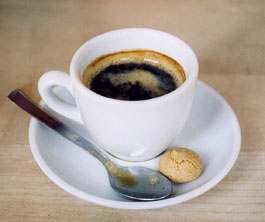 Have you noticed that (when you first open freshly roasted coffee) the beans are oily? Coffee oils contain most of the flavor and are also responsible for the “crema”, a dense, light brown foamy layer visible on top of your espresso. When stored in the freezer the oils shrink, crack to eventually fall off during the thawing process! As a result the extracted coffee lacks full aroma and the extracted espresso shot produces no crema. To preserve the flavor store your container in the room temperature. The key is to try and avoid fluctuations in temperature (don’t thaw and refreeze/re-refrigerate once coffee is brought back to room temperature).
Have you noticed that (when you first open freshly roasted coffee) the beans are oily? Coffee oils contain most of the flavor and are also responsible for the “crema”, a dense, light brown foamy layer visible on top of your espresso. When stored in the freezer the oils shrink, crack to eventually fall off during the thawing process! As a result the extracted coffee lacks full aroma and the extracted espresso shot produces no crema. To preserve the flavor store your container in the room temperature. The key is to try and avoid fluctuations in temperature (don’t thaw and refreeze/re-refrigerate once coffee is brought back to room temperature).
